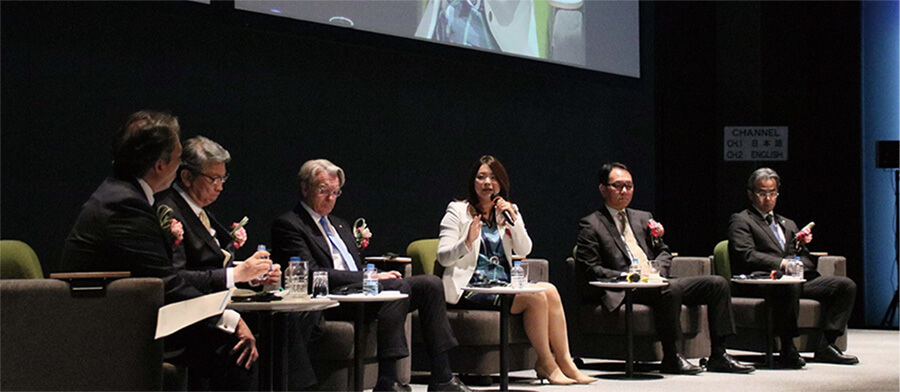In recent years, there is a growing interest by companies in collaborative creation as a way to generate innovation. Hitachi, which is promoting Social Innovation Business, and has developed and is applying its collaborative creation methodology NEXPERIENCE, has taken the next step to accelerate innovation by launching Kyōsō-no-Mori from its site in Kokubunji, Tokyo. Kyōsō-no-Mori, nestled in the woods of Musashio, will engage in collaborative creation with different stakeholders, including other companies, universities, and government agencies. For this article, Hitachi Review spoke to two of the key people about a range of subjects, including the background and objectives of Kyōsō-no-Mori, the features of the newly built research building, Kyōsō-tō, and the outlook for the future.
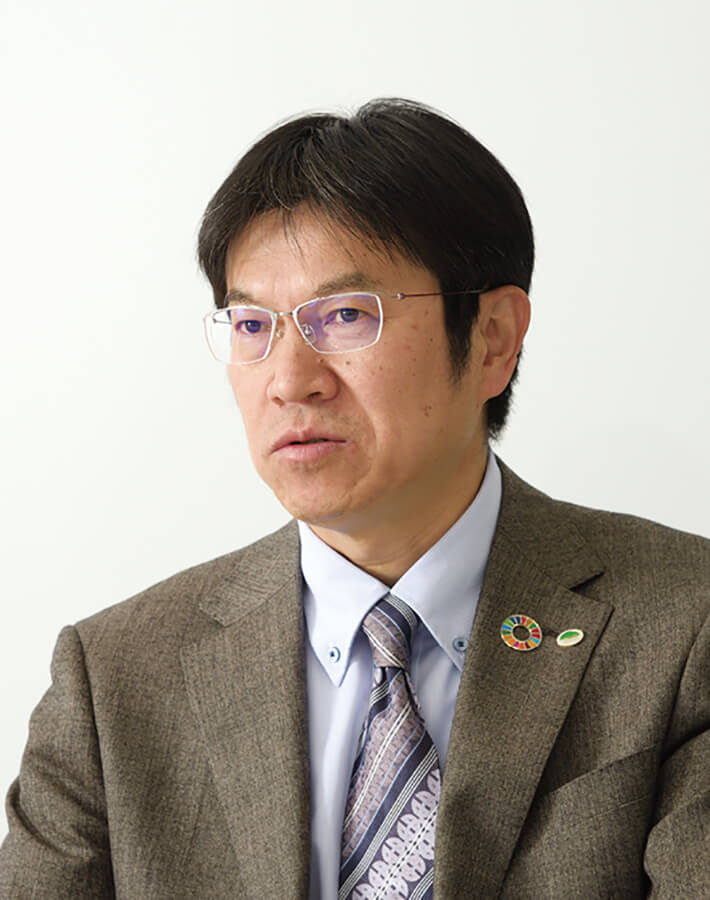 Yuichi Yagawa
Yuichi Yagawa
Deputy General Manager of the Center for Technology Innovation and General Manager of the Central Research Laboratory, Research & Development Group, Hitachi, Ltd.
Dramatic advances in digital technologies such as the Internet of Things (IoT) and artificial intelligence (AI) are bringing major changes to business and everyday life. Meanwhile, innovations made possible by these digital technologies have the potential to help overcome societal challenges such as global warming, resource depletion, rising economic disparity, cybersecurity threats, and aging populations combined with low birthrates. Yuichi Yagawa (Deputy General Manager of the Center for Technology Innovation), who currently heads the Central Research Laboratory, which has played a leading role in research and development at Hitachi, comments on this situation as follows.
“The aims of the Sustainable Development Goals (SDGs) adopted by the United Nations in 2015 and the Society 5.0 initiatives being promoted by the Japanese government are to overcome societal challenges while also giving purpose to life and maintaining sustainable economic progress. Unfortunately, in this time of uncertainty, there is a limit to how much Hitachi can do on its own to solve complex and increasingly serious societal challenges. This is why it has become so important to use collaborative creation through which Hitachi seeks to create a better future by working with a variety of stakeholders to reach consensus on the issues to be addressed and Hitachi's vision for this future, pooling its wisdom to create new value.”
Together with its focus on its Social Innovation Business, Hitachi has also undertaken a variety of initiatives in recent years aimed at becoming an innovation partner for customers. This has included a new structure for the Research & Development Group (R&D Group) in 2015 with three key pillars, the Global Center for Social Innovation (CSI), the Center for Technology Innovation (CTI), and the Center for Exploratory Research (CER), transforming it into an organization for collaborative creation with customers.
CSI works with customers to develop solutions, CTI develops the technical platform necessary for developing the solutions, and CER works to creates future Social Innovation Business from a long-term perspective. To date, CSI has functioned as the frontline organization promoting collaborative creation with customers utilizing NEXPERIENCE, its methodology for collaborative creation with customers, and Lumada, its platform for accelerating digital innovation.
Hitachi has now embarked on steps to take collaborative creation to the next stage. The focus of this activity is Kyōsō-no-Mori, launched in April 2019 from the Central Research Laboratory site in the Kokubunji, Tokyo (see Figure 1). Yagawa talks about the decision to create this Kyōsō-no-Mori, which is about to commence operations.
“Dr. Kumeo Baba, the first General Manager of the Central Research Laboratory, left to us the expression “Onore wo munashiushité tada fusei wo tsukusu,” urging us to eliminate our own selfishness and preconceptions, and to act in good faith with an unsullied heart and consideration for others. This represents the very starting point of collaborative creation, through which Hitachi seeks to create innovations that will be achieved in five to ten years and have an impact on society that will help achieve the early realization of the SDGs and Society 5.0.”
Figure 1—Kyōsō-tō at the Central Research Laboratory Constructed in the midst of trees, the Kyōsō-tō features an architectural design that takes account of the environment, including use of a high side terrace that encourages natural lighting and natural air flow and ventilation.
Constructed in the midst of trees, the Kyōsō-tō features an architectural design that takes account of the environment, including use of a high side terrace that encourages natural lighting and natural air flow and ventilation.
 Hiroki Kitagawa
Hiroki Kitagawa
General Manager, Global Center for Social Innovation – Tokyo, Research & Development Group, Hitachi, Ltd.
What Hitachi is seeking to do through Kyōsō-no-Mori is to create a prosperous and sustainable society that is human-centered and has a high quality of life (QoL). To achieve this, Hitachi intends to engage in open innovation based on three core strategies, namely a new form of collaborative creation, coexistence with nature, and work practices that promote creativity. As indicated by Yagawa's comments quoted above, a key feature of these strategies is that they require a more open and multifaceted approach based on collaborative creation that brings together a number of different stakeholders (see Figure 2).
Hiroki Kitagawa (General Manager of the Global Center for Social Innovation – Tokyo, Hitachi, Ltd.), who along with establishing infrastructure for NEXPERIENCE has been a driving force behind CSI's collaborative creation activities, explains the outcomes and challenges of NEXPERIENCE.
“The R&D Group began working with companies on collaborative creation at the same time as CSI was launched, with the number of projects using NEXPERIENCE reaching 1,000 in FY2018, up from 175 in FY2016. Results have included coming up with new solutions. A difficultly with the past practice of one-to-one collaborative creation, however, is that it is not easy to expand to other partners or scale globally. An important factor in successful up-scaling is the building of a global innovation ecosystem that creates a large amount of value through the application of a wider range of knowledge and insights from both inside and outside the company, including researchers and designers from Hitachi, startup companies, community residents, and universities. In the ecosystems built through Kyōsō-no-Mori, the goal is to come up with innovative digital solutions and services through open innovation that evolves from one-to-one collaborative creation.”
With regard to the core strategy of coexistence with nature, construction at the Central Research Laboratory followed a tradition of protecting the natural environment of the Musashino area where it is located, keeping the felling of trees to a bare minimum by honoring the wishes of Hitachi's founding president, Namihei Odaira, to “build around existing trees rather than cut them down.” The name, Kyōsō-no-Mori, embodies the idea of growing along with the forest, developing relationships of collaborative creation with customers and other partners in the rich natural environment. The idea is that coexistence with a rich and protected natural environment delivers value by facilitating a deepening of researchers' spirit of inquiry and building heart-to-heart connections between the people who come to the site so that they come up with ideas that are large in scale and then go on to foster major innovations.
The third core strategy of adopting working practices that promote creativity, meanwhile, expresses the aim that doing so will allow everyone who enters Kyōsō-no-Mori to get enthusiastically involved. While this incorporates the point of view that a more open and multifaceted approach based on collaborative creation is needed, it was also a notable feature in the process of the projects leading up to launching Kyōsō-no-Mori.
Figure 2—Block Diagram of Open Innovation Ecosystem The diagram shows Hitachi’s approach to open innovation. This involves the development of major businesses by using collaborative creation with partners to take on societal challenges.
The diagram shows Hitachi’s approach to open innovation. This involves the development of major businesses by using collaborative creation with partners to take on societal challenges.
Kyōsō-no-Mori includes the pre-existing Odaira Kinen-kan and Jinsō-tō, as well as a new facility, Kyōsō-tō, the first building to be built at the Central Research Laboratory in 26 years. When planning the new building, the design focused not on what its interior would be used for, but on what sort of work practices would be adopted. This drew on the experience and know-how gained when the office of CSI – Tokyo (previously the Design Division) was established in Akasaka, Tokyo in 2008, and from the design chosen to facilitate creative work practices. What this meant in practice was an approach in which the staff of CSI – Tokyo, whose office was to be moved to the Kyōsō-tō, played a central role in formulating a vision whereby people from outside the company would bring their issues and work to resolve them through collaborative creation with Hitachi. This included producing use cases for different work practices that would bring this about.
As Kitagawa said, “Whereas past work practices involve a three-way relationship between the laboratory, business division, and customer, the achievement of open innovation requires work practices that draw on knowledge from outside, including from partners, universities, and the community. The R&D Group settled on four types of work practices. In addition to those practices that accelerate collaborative creation using outside knowledge, as mentioned, the others were to test ideas by putting them into practice, to engage in collaborative creation with researchers from other disciplines, and flexible working. Based on typical use cases for each type of work practice, the requirements definition was transformed into a design after first having identified the basic intentions for the spaces, their main users, main uses, security policies, and spatial and equipment requirements.”
Another important factor in the execution of the project was the holding of activities in which everyone could participate. This presented the spectacle of the R&D Group themselves engaging in collaborative creation, holding a workshop attended by all of the people who would come together in the Kokubunji district and inviting experts including Professor Noboru Konno of the Tama Graduate School of Business, who is recognized as the pre-eminent expert in the field of knowledge creating management. The workshop activities included reaching a consensus on the basic thinking behind the vision, use cases, and other considerations, and engaging in ongoing discussions to collate the points at issue, representing a collaborative creation between researchers in the R&D Group.
Through this process, the design took shape in the form of the first-floor Café Library and NEXPERIENCE spaces that embody the idea of accelerating collaborative creation using outside knowledge, the second-floor project spaces that embody the idea of testing ideas by putting them into practice, and the communication corridor that embodies the idea of flexible work (see Figure 3). While some areas remain closed to protect confidentiality, the one word that captures the feeling of the Kyōsō-tō is “open.” The third floor of the Kyōsō-tō hosts CTI's Digital Technology Innovation Center and the fourth floor is home to the offices of CSI – Tokyo, with researchers from different fields able to mingle in the communication corridor. As Kitagawa explains, “Hitachi's aim is to generate chemistry by bringing different groups together, including by doing away with the barriers between floors both in a spatial sense and in terms of how the organization is run.” Moreover, because walls are only present where they form part of the structure of the building, the collaborative creation spaces convey a palpable feeling of being in a forest, with a good view of the outside from anywhere on the interior floors.
Meanwhile, measures are being taken to improve the success rate and speed of idea commercialization in collaborative creation with external partners. The practice of coming up with innovations is built into the interior of the Kyōsō-tō, involving a rapid cycle of taking on the future challenges presented in Hitachi Baba Memorial Hall, generating ideas in the NEXPERIENCE space, and utilizing Hitachi's advanced technologies to prototype and test them.
Yagawa comments that, “Along with conducting ideathons and hackathons where the R&D Group considers what approach to take to societal problems, starting by raising the problem to be addressed, the respective spaces each play their own role, such as incorporating technology from partners. The company can also speed this up further by working with the Jinsō-tō, which is equipped for rapid prototype development. Furthermore, the sequence of steps through which ongoing trials are conducted proceeds in an agile and spiral fashion in keeping with the uncertainties of these times, something Hitachi believes is important for coming-up with better outcomes.”
In this way, the ability to engage in activities that combine NEXPERIENCE and technology gives Kyōsō-no-Mori a different character to Hitachi's existing facilities at its collaborative creation space in the Akasaka district of Tokyo and the open laboratory at its Yokohama Research Laboratory. Hitachi also plans to network these sites, with each one taking on a role that suits its characteristics. For example, the centrally located collaborative creation space in Akasaka is where Hitachi's potential for collaborative creation is demonstrated and also serves as an entry point to the deepening of open collaborative creation at Kyōsō-no-Mori.
Figure 3—Spaces for Supporting and Accelerating Collaborative Creation The Café Library (top left) is a communication space that uses bookshelves to demarcate space. It can also be used to host casual performances or workshops. The project spaces are made up of the project base (top right) and project room (bottom left) for engaging in collaborative creation with partners and can be used to hold workshops or develop physical prototypes, in the process providing hands-on experience of Hitachi’s state-of-the art technology. The Hitachi Baba Memorial Hall (bottom right) has a capacity of 350 people and provides a venue for discussions with a variety of stakeholders, and is also being designed with the hosting of international conferences in mind.
The Café Library (top left) is a communication space that uses bookshelves to demarcate space. It can also be used to host casual performances or workshops. The project spaces are made up of the project base (top right) and project room (bottom left) for engaging in collaborative creation with partners and can be used to hold workshops or develop physical prototypes, in the process providing hands-on experience of Hitachi’s state-of-the art technology. The Hitachi Baba Memorial Hall (bottom right) has a capacity of 350 people and provides a venue for discussions with a variety of stakeholders, and is also being designed with the hosting of international conferences in mind.
Addressing the question of what Kyōsō-no-Mori will actually do in the future to create a sustainable society that is human-centered and has a high QoL, Yagawa has the following to say.
“Kyōsō-no-Mori accelerates innovation through a rapid cycle of prototyping and testing in the project spaces using Hitachi's Lumada IoT platform and other leading-edge technologies. To achieve this, the R&D Group has established the Kyōsō-no-Mori Partner Program and embarked on projects with customers and other partners. Among the work currently being considered are digital smart office and future living lab projects, including projects that use the complementary metal-oxide-semiconductor (CMOS) annealing machine to find rapid solutions to complex real-world problems, traffic congestion being one example application. Research topics cover a wide range, including autonomous cooperative robots, energy management, and smart offices, with Hitachi's aim being to take ideas that emerge from discussions at Kyōsō-no-Mori with people from all around the world and to utilize digital technology and collaborative creation to implement them and put them into practice.”
Accordingly, the partnership with the local municipality of Kokubunji has taken on importance. The R&D Group has already (in October 2018) signed a comprehensive partnership agreement with Kokubunji City on the use of innovation for regional revitalization and is currently undertaking a project with city residents on the theme of “connecting the community.”
Kitagawa says, “In addition to providing an app to help with a local vegetable-growing project aimed at making Kokubunji more self-sufficient in vegetables, Hitachi is also currently trialing an electronic community currency. If you consider the nature of Hitachi's Social Innovation Business, then clearly, the company cannot overlook the views of the local residents who make up its users. When addressing societal issues such as the QoL, safety and security, and levels of activity of residents, if Hitachi can make a successful model out of measures taken by local governments such as that of Kokubunji City, then the company believes that this will provide a pathway to expanding the solution to the national level or to cities that have been designated by government ordinance.”
In acknowledgement of the SDGs and Society 5.0, Hitachi's 2021 Mid-term Management Plan emphasizes the provision of social, environmental, and economic value. High hopes are also being placed on Kyōsō-no-Mori, for example, the hope that, by putting such solutions into practice, it will be able to generate social value and environmental value whereby digital technology is used to protect an abundant nature. In response to these expectations, Yagawa expresses the view that, “This is the only place where Hitachi can combine the design capabilities of CSI, the technical capabilities of CTI, and the scientific capabilities of the CER. Strong innovation is possible through these combined capabilities and collaborative creation with a large number of different stakeholders.”
The R&D Group celebrated the centenary of its founding in 2018. Now, a new challenge has begun for Kyōsō-no-Mori as it seeks to become a base for spreading innovation while cultivating the seeds of innovation into a vast forest for the next 100 years (see Figure 4).
Figure 4—Odaira Kinen-kan Renovated for the Opening of Kyōsō-no-Mori Along with being a venue for open innovation, the site is also intended as a base for spreading innovation to the world, including construction of the new Vision Lounge of the Odaira Kinen-kan and providing opportunities throughout Kyōsō-no-Mori to experience Hitachi’s latest capabilities.
Along with being a venue for open innovation, the site is also intended as a base for spreading innovation to the world, including construction of the new Vision Lounge of the Odaira Kinen-kan and providing opportunities throughout Kyōsō-no-Mori to experience Hitachi’s latest capabilities.
On April 11, 2019, Hitachi held a ceremony attended by approximately 300 invited guests to celebrate the opening of Kyōsō-no-Mori, its new research and development facility. An exhibition, commemorative ceremony, and a symposium on “Realizing a sustainable human-centered society with a high QoL” gave a wide-ranging introduction to Hitachi’s efforts to create value through collaborative creation with customers and other partners, with Kyōsō-no-Mori serving as a new departure point as work proceeds on the SDGs, and on Society 5.0 in Japan.
 Toshiaki Higashihara
Toshiaki Higashihara
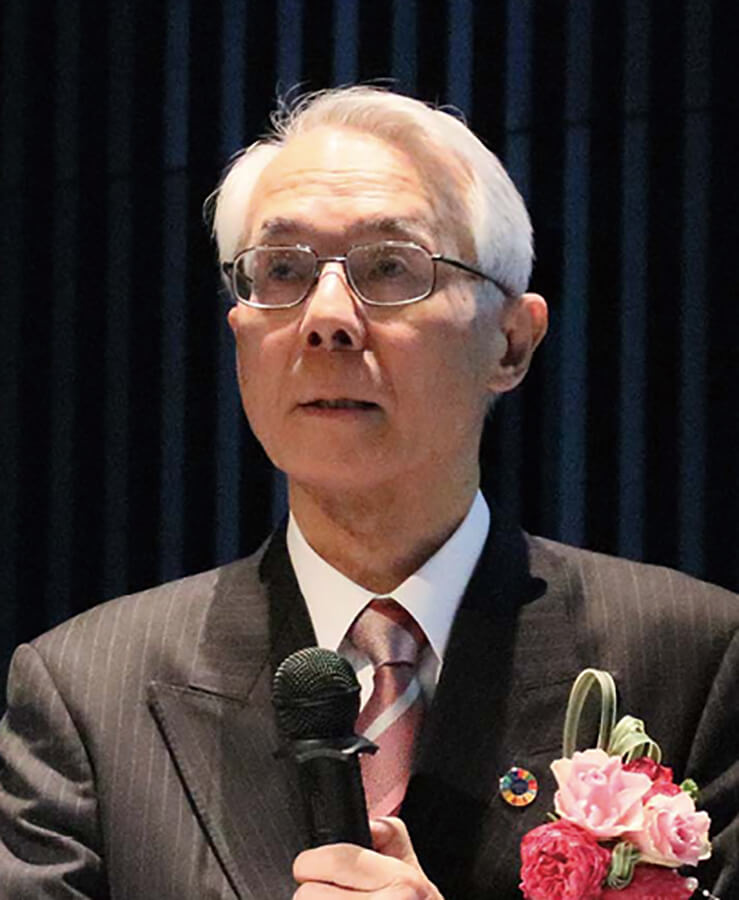 Michiharu Nakamura
Michiharu Nakamura
In front of a full house of invited guests at the Hitachi Baba Memorial Hall, Hitachi representatives including Hitachi Representative Executive Officer, President, Chief Executive Officer (CEO), and Director Toshiaki Higashihara gave presentations on the role Hitachi is seeking to play and the expectations for innovation in which Kyōsō-no-Mori will play an integral part. President Higashihara made the point that collaborative creation with a wide variety of different stakeholders is the key to enhancing social, environmental, and economic value, saying, “More important than anything else in being ahead of the rest of the world in achieving the human-centered society envisaged by Society 5.0 will be technologies for linking different data together and the ability to illuminate data to uncover value. Kyōsō-no-Mori will provide an environment for linking data with data and people with people. I sincerely hope that Hitachi can all work together from here on to come up with new innovations that will change the world's future.” He also talked about the intentions for utilizing resources like Lumada and NEXPERIENCE as platforms for value creation.
Norihiro Suzuki, Vice President and Executive Officer, Chief Technology Officer (CTO) and General Manager of the Research & Development Group, and General Manager of the Corporate Venturing Office announced that “Kyōsō-no-Mori will develop initiatives that seek to resolve societal issues in collaboration with a wide variety of partners, and will take on the challenge of becoming a global innovation leader for the coming 100 years.” Yuichi Yagawa, Deputy General Manager of the Center for Technology Innovation and General Manager of the Central Research Laboratory in the Research & Development Group, used a video to express the vision that Kyōsō-no-Mori is aiming to realize, talking about the intention to utilize digital and other advanced technologies to achieve this.
The keynote address that concluded the commemorative ceremony, given by Michiharu Nakamura (a former Executive Vice President and General Manager of the Research & Development Group at Hitachi, now a member of the United Nations 10-Member Group) and entitled, “Hopes for Research and Development at Hitachi with a Central Role for Kyōsō-no-Mori” included the comment that, “With the negative aspects of science and technology having come to the fore in recent years, there is a strong desire for a society that is both sustainable and leaves nobody behind, a sentiment that led to the adoption of the United Nation's SDGs. Bringing about the society envisaged by the SDGs will require that we act with a strong sense of urgency, with contribution from the private sector being essential.” He also offered some words of hope, saying “I look forward to you contributing to the progress of customers and other parts of society with a central role for Kyōsō-no-Mori, which holds nature dear and is blessed with a diversity of human resources.”
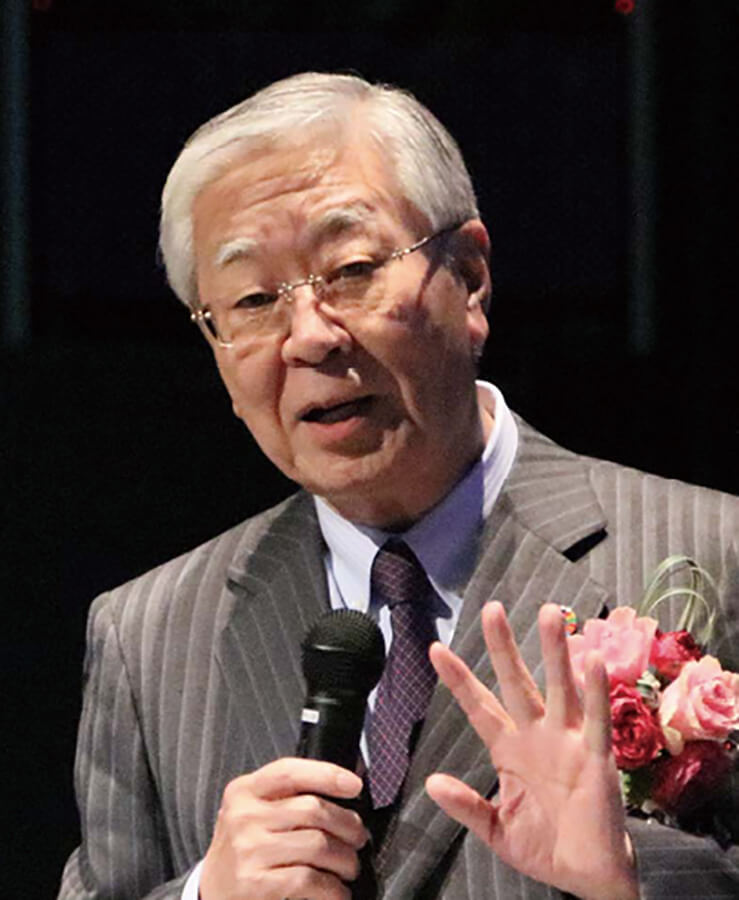 Hiroaki Nakanishi
Hiroaki Nakanishi
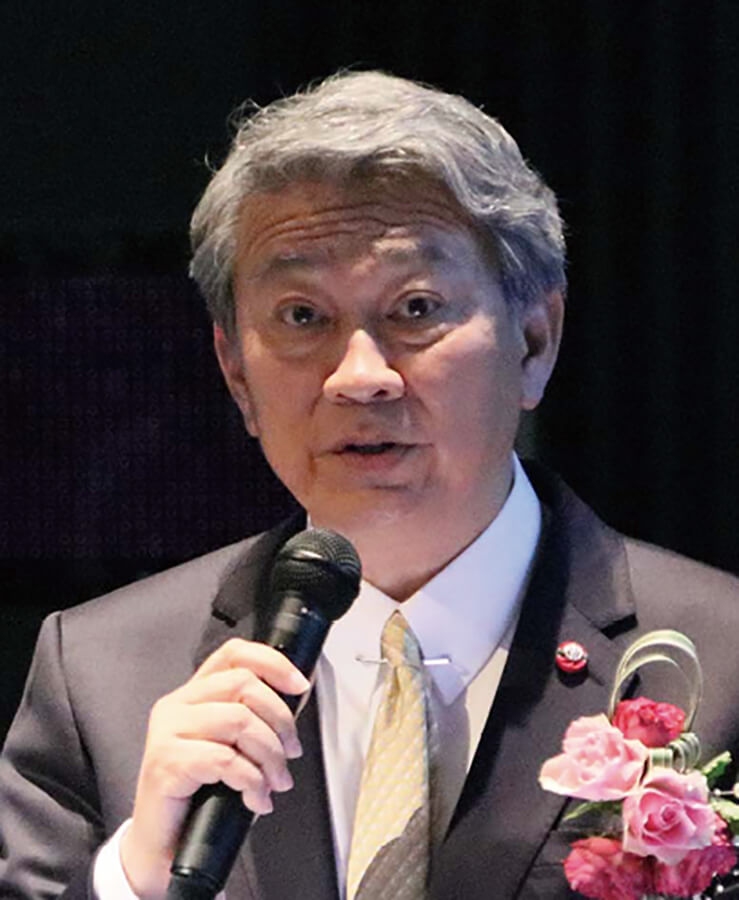 His Excellency
His Excellency
Bansarn Bunnag
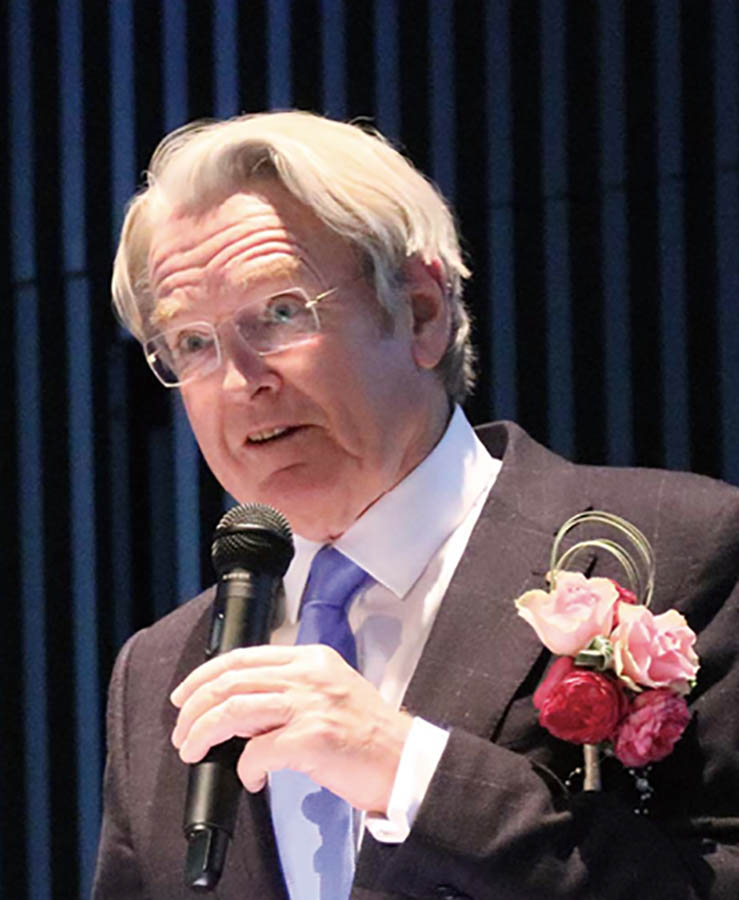 His Excellency
His Excellency
Hon. Richard Court AC
Based on its theme of “achieving a prosperous and sustainable society that is human-centered with a high QoL,” a panel discussion on smart cities in the Asia-Pacific region that have grown in vigor along with the advances in digitalization turned into a lively debate.
Hiroaki Nakanishi (Executive Chairman of Hitachi) started by pointing out the importance of pursuing Society 5.0 in a way that engages the wave of digitalization head on and of contributing globally through value creation. Smart cities are central to these trends, and in expressing his hopes that the subsequent discussion would be a meaningful one, he commented on this topic by saying, “Rather than just being a problem for governments or individual companies, it is important to have venues for vigorous discussion that combine the strengths of industry, government, and academia.”
Next to take the stage was His Excellency Bansarn Bunnag, Ambassador of the Kingdom of Thailand, who was representing the guests and gave a presentation entitled “Thailand's Sustainable Growth Strategy.”
Along with enumerating the six key actions identified in Thailand National Strategy for 2018–2037 that was adopted by the Thai government in 2018, he also pointed out similarities between Japan's Society 5.0 and the Thailand 4.0 model that should help achieve these goals and that commenced a year earlier, emphasizing that “The most important partnership in work toward digitalization is that between Japan and Thailand, and Hitachi has a large role to play as a supporter of innovation.”
Also representing the guests was His Excellency Hon. Richard Court AC, Australian Ambassador to Japan, who gave a presentation entitled, “Future Cities – Future Infrastructure – Australia-Japan collaboration.”
After first giving an overview of the challenges facing Australia today, which include faster than expected population growth, while also talking about the future of cities and of industry, he went on to express his hopes for open innovation with Hitachi, making the point that collaborative creation with Japanese companies would improve the country's QoL.
Following the ambassadorial presentations was a panel discussion that debated contribution to the current status and future outlook for smart cities, addressing the topics of value, technology, and collaborative creation.
With regard to value, Professor Atsushi Deguchi (Graduate School of Frontier Sciences, The University of Tokyo) said, “Next-generation smart cities will incorporate the ideas of society being data-driven, knowledge-intensive, and focused on non-monetary value,” describing the Habitat Innovation work by Hitachi-UTokyo Laboratory aimed at putting this into practice. His Excellency Bansarn Bunnag and His Excellency Richard Court gave examples from their own countries as they spoke about how the scope of value in smart cities is expanding, including sustainability, livability, and the environment.
With regard to technology, Shigetoshi Sameshima (General Manager, Center for Technology Innovation, Research & Development Group, Hitachi, Ltd.) used examples of what is being done to talk about the relationship between digitalization and value creation, saying, “The potential for digital innovation is huge, both for enhancing value and for dealing with the unexpected.”
Taking these discussions on board, debate about collaborative creation included Chizuru Suga (Head of the World Economic Forum Centre for the Fourth Industrial Revolution Japan) advocating, “Urban spatial information acquired from sensors is a public good. Likewise, for the benefit of society, it is important for open innovation to establish an environment to which anyone can have access, and the creation of global rules is the greatest key to achieving this.” She also emphasized that, “Before smart cities can be realized in practice, collaborative creation with multiple stakeholders such as local governments and residents will be essential,” expressing her hopes for the future by saying, “I hope we can make progress by trial and error at open facilities like Kyōsō-no-Mori”
The panel discussion, which went on for nearly two hours, concluded with the moderator, Kojin Nakakita [Vice President and Executive Officer in Charge of Regional Strategies (APAC), Chairman of Hitachi Asia Ltd., and Chairman of Hitachi India Pvt. Ltd.], saying, “Let's work together with the aim of using digitalization to create smart cities, following the directions that have come to light during today's discussions,” marking out a path that is in keeping with the launch of Kyōsō-no-Mori as a new facility for open innovation.
